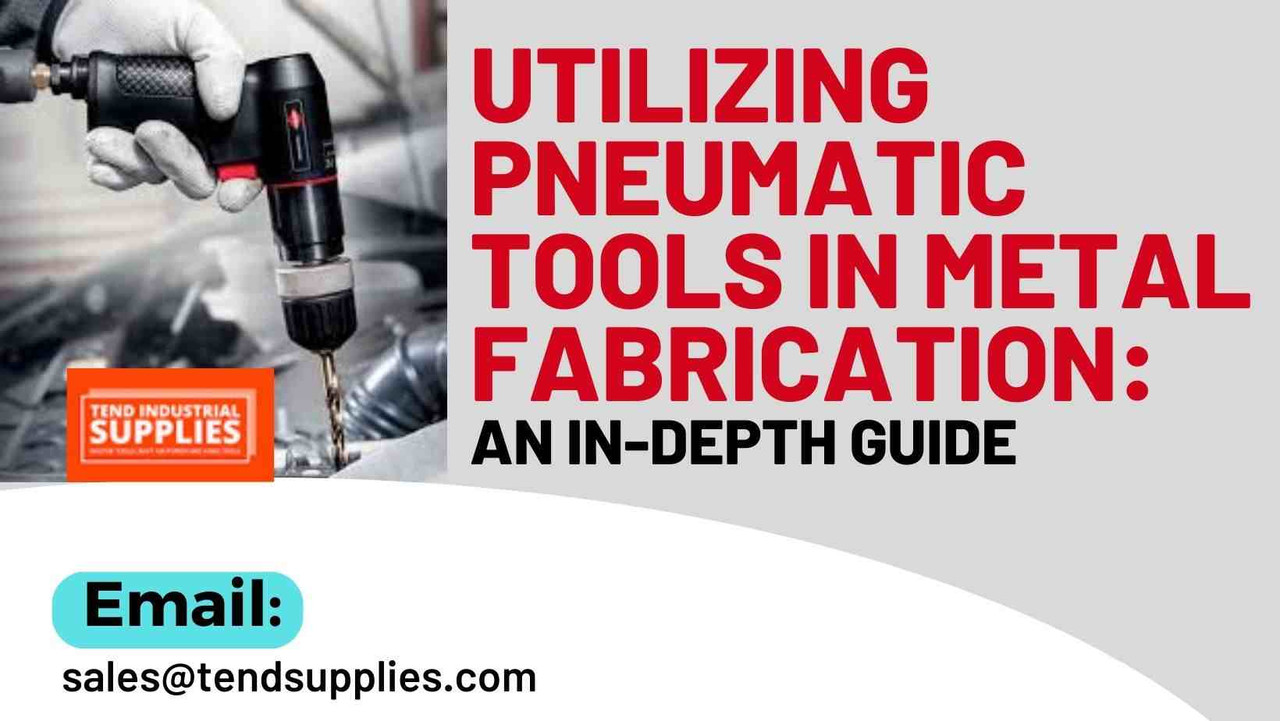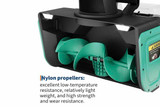Utilizing Pneumatic Tools in Metal Fabrication: An In-Depth Guide
Introduction
Pneumatic tools transform compressed air into mechanical energy, which is vital for metal fabrication. This guide underscores the importance of selecting suitable tools to boost productivity and quality in metalwork.
Fundamentals of Pneumatic Tools
Pneumatic tools operate on compressed air, distinguishing them from electric or hydraulic counterparts. They offer unique advantages such as safety and portability, setting a new standard in metal fabrication.
Advantages of Using Pneumatic Tools in Metal Fabrication
- Efficiency and Speed: Pneumatic tools streamline operations, leading to faster completion of metal fabrication projects.
- Precision and Accuracy: These tools provide unmatched precision, crucial for intricate metalwork.
- Safety Features: With lower risks of electric shocks and sparks, pneumatic tools enhance workshop safety.
- Cost-Effectiveness: They offer a cost-efficient solution due to lower energy consumption and maintenance costs.
- Durability and Maintenance: Built to last, pneumatic tools require minimal maintenance, ensuring long-term reliability.
Critical Applications of Pneumatic Tools
Pneumatic tools serve various purposes in metal fabrication, from cutting and drilling to polishing and bending. This section will detail how these tools are applied in real-world metalworking scenarios.
Selecting the Appropriate Pneumatic Tools
Choosing the right tool involves considering power requirements, size, and air pressure compatibility. This section will guide users in effectively matching pneumatic tools with specific metal fabrication tasks.
Criteria for Selection:
- Power: Assess the energy required for various tasks to ensure the tool can handle the metal fabrication workload.
- Size: Choose a tool size that matches the work environment and the specifics of the task.
- Air Pressure: Ensure the tool's air pressure requirements align with the workshop’s air compressor capacity.
Matching Tools to Fabrication Tasks:
Select tools based on the specific requirements of tasks such as cutting, drilling, or bending to optimize efficiency and results.
Best Practices in Pneumatic Tool Usage
When using pneumatic tools, you should follow these best practices as first reading the manual, wearing protective gear appropriate for the work, setting up screens or shields, ensuring that the compressed air is clean and dry, and ensuring your tools are adequately maintained. Others are installing safety clips and minimizing vibrations by using only recommended attachments. Others are:
- Safety Protocols and Equipment: Use protective gear and follow established safety protocols to prevent accidents.
- Maintenance Tips for Tool Longevity: Regular cleaning and inspection can extend tool life and maintain performance.
- Training for Operators: Proper training ensures safe and effective tool use, contributing to better outcomes and fewer injuries.
Overview of Popular Pneumatic Tools in Metal Fabrication
Metal fabrication involves various tasks requiring specific tools to achieve optimal efficiency and results. Here's a list of the most popular pneumatic tools commonly used in metal fabrication:
Cutting and Shearing:
Air Cut-Off Tool: This versatile tool offers precise and clean cuts in sheet metal, tubing, and other thin materials.
Air CutOff Tool metal fabrication
Air Shears: Similar to air cut-off tools, air shears specialize in making straight and curved cuts in sheet metal of varying thicknesses.
Air Shears metal fabrication
Air Nibbler: Designed for creating intricate shapes and patterns in sheet metal, air nibblers offer controlled, bite-sized nibbles, allowing for smooth curves and intricate designs.
Air Nibbler metal fabrication
Drilling and Fastening:
Air Drill: Offering variable speed control and power, air drills are essential for various drilling tasks in metal, ranging from precise pilot holes to larger diameter holes.
Air Drill metal fabrication
Air Hammer: This powerful tool delivers high-impact blows for driving rivets, chiseling metal, and breaking concrete or masonry.
Air Hammer metal fabrication
Air Die Grinder: Featuring a smaller profile and high speed, air die grinders excel at grinding, cleaning, and deburring metal surfaces in tight spaces.
Air Die Grinder metal fabrication
Air Angle Grinder: Similar to air die grinders, air angle grinders offer a more angled head design, allowing for greater reach and access in confined areas.
Air Angle Grinder metal fabrication
Air Impact Wrench: This powerful tool is ideal for tightening and loosening nuts and bolts quickly and efficiently, saving time and effort during assembly and disassembly tasks.
Air Impact Wrench metal fabrication
Air Screwdriver: Offering precise torque control, air screwdrivers are beneficial for driving screws of various sizes with consistent torque, ensuring proper fastening without damaging the material.
Air Screwdriver metal fabrication
Other Notable Tools:
Air Sander: Ideal for smoothing and finishing metal surfaces, air sanders offer a smooth and efficient sanding experience.
Air Sander metal fabrication
Needle Scaler: This specialized tool utilizes rapid needle vibrations to remove rust, scale, and paint from metal surfaces, offering precise cleaning in tight areas.
Needle Scaler metal fabrication
The specific choice of tools will depend on the particular metalworking tasks and materials involved. However, these popular pneumatic tools cover many applications and are essential for efficient and productive metal fabrication processes.
Features and Benefits Analysis:
Each tool offers unique advantages, such as improved speed, precision, or safety, contributing to their popularity in metal fabrication.
Impact Analysis: Productivity and Efficiency Using Pneumatic Tools in Metal Fabrication
Introduction:
Pneumatic tools are air-powered devices widely used in metal fabrication due to their power, versatility, and portability. Analyzing their impact on productivity and efficiency in this industry is crucial for businesses to make informed decisions regarding equipment selection and workflow optimization.
Positive Impacts:
- Increased Speed: Pneumatic tools generally operate at higher speeds than manual tools, allowing tasks like drilling, grinding, and cutting to be completed faster. This translates to quicker project completion times and potentially increased output.
- Reduced Effort: The power of pneumatic tools reduces the physical exertion required from workers, minimizing fatigue and potential injuries. This leads to improved worker well-being and potentially fewer work stoppages.
- Enhanced Accuracy: Certain pneumatic tools, like controlled torque wrenches, offer greater precision than manual tools. This reduces errors and rework, improving overall quality and production efficiency.
- Improved Accessibility: The compact size and maneuverability of pneumatic tools allow access to tight spaces and intricate metalwork that might be difficult or impossible with bulkier electric tools. This expands the possibilities and efficiency of certain tasks.
- Reduced Operational Costs: While initial investments in pneumatic tools might be higher, their durability and lower maintenance requirements than some electric tools can lead to long-term cost savings.
Potential Challenges:
- Noise Pollution: Pneumatic tools can generate significant noise levels, requiring workers to use proper hearing protection. This can be a disadvantage in work environments with strict noise regulations or when employee comfort needs to be prioritized.
- Air Supply Dependency: The performance and efficiency of pneumatic tools rely heavily on the quality and consistency of the compressed air supply. Fluctuations or limitations in air pressure can negatively impact performance and productivity.
- Skill and Training: While user-friendly, operating pneumatic tools effectively requires proper training and practice to ensure safety, maximize efficiency, and avoid tool damage.
- Potential Safety Issues: Improper use of pneumatic tools can lead to serious injuries like lacerations, punctures, or eye damage. Implementing appropriate safety protocols and training is crucial.
- Environmental Considerations: Compressed air generation can consume significant energy. Choosing energy-efficient air compressors and responsible waste disposal procedures are essential for ecological sustainability.
Overall Impact:
The impact of pneumatic tools on productivity and efficiency in metal fabrication is generally favorable. Their speed, reduced effort, and improved accessibility lead to faster completion times, reduced labor costs, and potentially higher production output. However, it's crucial to acknowledge the potential downsides such as noise pollution, air supply dependency, and safety concerns. By considering both advantages and challenges, businesses can make informed decisions about incorporating pneumatic tools into their metal fabrication processes while ensuring worker well-being, environmental awareness, and overall operational efficiency.
Additional Considerations:
- Comparing specific tasks and projects to determine if pneumatic tools offer significant advantages over alternative options.
- Evaluating the cost-benefit analysis, considering initial investment, maintenance costs, and potential long-term savings.
- Implementing proper training and safety protocols to ensure safe and efficient tool operation.
- Exploring newer technologies like cordless or battery-powered tools that might address some challenges associated with traditional pneumatic tools.
By conducting a comprehensive analysis and considering all aspects, businesses can optimize their metal fabrication processes using pneumatic tools while achieving improved productivity, cost-effectiveness, and safety.
Conclusion
In conclusion, pneumatic tools offer significant advantages in metal fabrication, including enhanced efficiency, precision, and safety. Their wide range of applications, from cutting and drilling to polishing and bending, demonstrates their versatility and indispensability in modern metalwork practices.
Tend Industrial Supplies LLC is at the forefront, providing an extensive selection of pneumatic tools tailored to meet the diverse needs of metal fabrication processes. By integrating these advanced tools, businesses can significantly improve their operational efficiency and product quality.
Call to Action
We invite you to explore the comprehensive range of pneumatic tools Tend Industrial Supplies LLC offers. Discover how our products can streamline your metal fabrication tasks, ensuring superior results and higher productivity. For more information or to discuss your specific needs, contact us today. Let Tend Industrial Supplies LLC be your partner in optimizing your metal fabrication processes with our state-of-the-art pneumatic tools.
Related articles
The Ultimate Guide to Selecting the Perfect Air Tools
The Essential Guide to Pneumatic Tools in Industrial Settings: Maximizing Efficiency and Safety
Air Tool Maintenance: Ensuring Efficiency and Longevity









